 |
|
| SEARCH | TEACHER OST INSTITUTE | ||||
|
Teacher Ocean Technology Institute (TOTI) 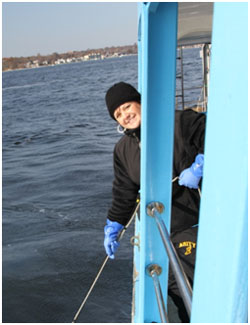 Day 1 of the TOTI began with a broad introduction to ocean technology and applications for science and exploration, followed by a brief overview of the COSEE-TEK program. In the afternoon, UCONN scientists who collaborated in the summer TTEs provided a profile of their research activities, methods, and associated ocean technologies, including tours of their research laboratories, where they learned more about relevant investigations being conducted. 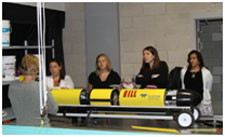 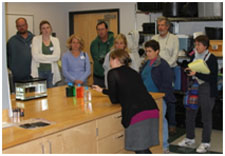 Then, Dr. Heidi Dierssen discussed a wide array of ocean imagery spanning from underwater photographs to airborne hyperspectral imagers to satellite remote sensing and how these data-rich resources can illuminate themes such as habitat classification and camouflage. In the laboratory, educators participated in hands-on demonstrations of light transmission and absorption in water and experimented with a simple activity on the polarization of light. 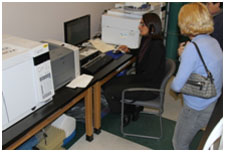 Following each tour, the TTE participants presented their ideas to the group for lesson plan and educational resource development. The informal, open nature of these discussions spurred many interesting discussions about incorporating these research topics in the classroom. Technology Panel To conclude Day 1 of the 2011 TOTI, a panel of marine researchers presented on three areas of ocean technology and associated research applications. The purpose of this technology panel was to highlight technologies that will be utilized in next summer’s TTEs and generate interest for future educator participants. The plan for 2012 will focus on broad-scale underwater mapping technologies including multibeam and side scan sonar can expeditiously provide a wealth of information about seafloor topography. These seafloor mapping efforts will be “groundtruthed” using remotely operated vehicle (ROV) and towed camera sled technologies to provide visual confirmation of seafloor habitats and provide additional data on species abundance and diversity, geology, and water quality. Using these technologies in tandem allows researchers to make strong inferences about broad scale marine habitat dynamics. The first presentation given by Brian Calder of the University of New Hampshire’s Center for Coastal and Ocean Mapping was titled “Ocean Mapping with Multibeam Echosounders” Dr. Calder addressed the use of multibeam and backscatter acoustics to explore the seafloor and water column. Innovative developments in the area of marine acoustics have also been used to assess the condition of port structures, map shipwreck targets for better navigation and further exploration, and even identify schooling fish in the water column. The second presentation by Kevin O’Brien of Connecticut’s Department of Energy and Environmental Protection was titled “Benthic Mapping in Long Island Sound: Perspectives from Coastal Management”. This focused on the use of acoustic mapping products and data presented in geographic information systems to make better decisions about land use in and around Long Island Sound. To conclude, Eric Heupel, a graduate student in UCONN’s Marine Science Program, gave a perspective of how landscape ecologists use habitat maps combined with underwater video of fish and invertebrates to make better inferences about important habitats for marine conservation. 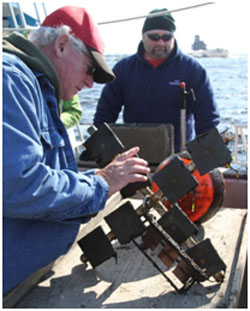 On Day 2 of the TOTI, participants began the day by climbing aboard Project Oceanology’s R/V Enviro-Lab II to experience for themselves some of the technologies in action. The cruise began with a 20-minute bottom trawl to collect specimens for camouflage studies. Specimens included spider crabs, rock crabs, mantis shrimp, skate and winter flounder (the latter were used for the camouflage work). After the trawl, participants worked with a Conductivity, Temperature and Depth (CTD) sonde to measure the physical characteristics of various sites within Eastern Long Island Sound (see image below). The cruise concluded with a recovery of one of the local BOBs within the Thames River. Educators replaced the EVA passive samplers and took photos of the settlement plates for later analysis and to add to the education resources available on the COSEE-TEK website. 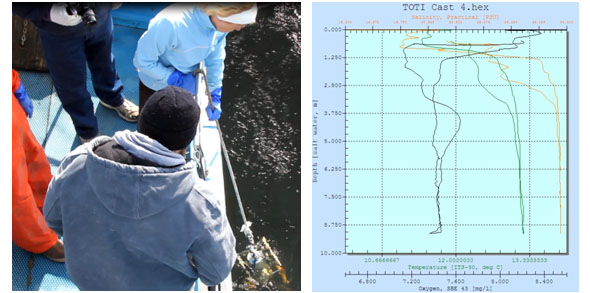 TOTI Conclusion The TOTI concluded with an engaging roundtable discussion of the results of the two-day workshop and how the educational resources being developed could be used in the classroom. Of particular note, most of the educators were eager to adopt the EVA & BOB initiative into their curriculum and science classroom activities. COSEE-TEK plans to continue this TTE for 2012, but is also seeking additional funds to leverage this exciting initiative as a growing collaboration of citizen science throughout the country, ideally spearheaded by the COSEE Network. In addition, one teacher is taking the lead on developing a student produced “TEKipedia” by encouraging students to explore a particular ocean technology and develop a detailed profile of the instrument including research application, advantages, disadvantages, images, video, data, and publications illustrating the development and applications of these technologies. COSEE-TEK plans to host the TEKipedia on its website and will encourage teachers to challenge students to build this educational resource. |






